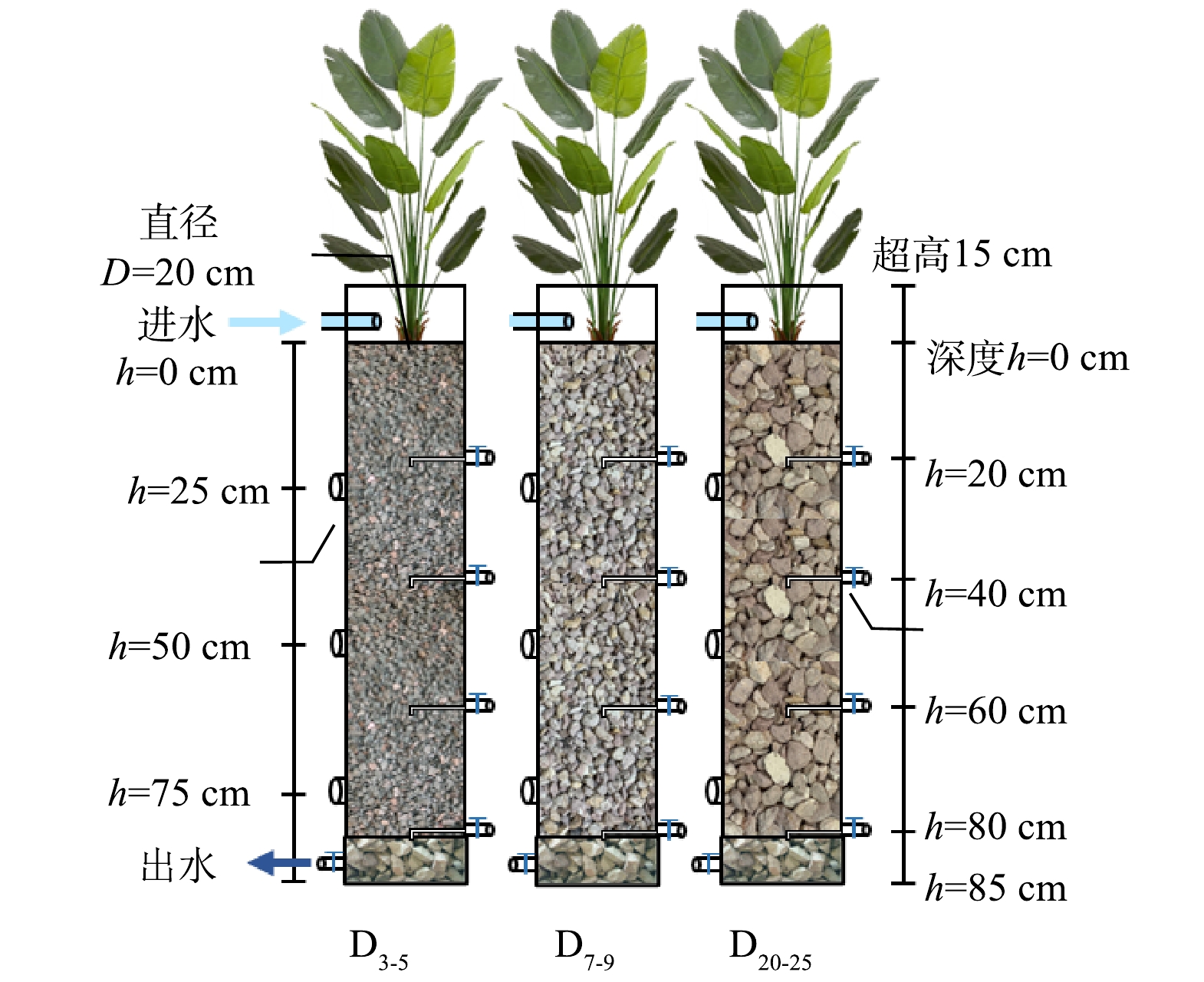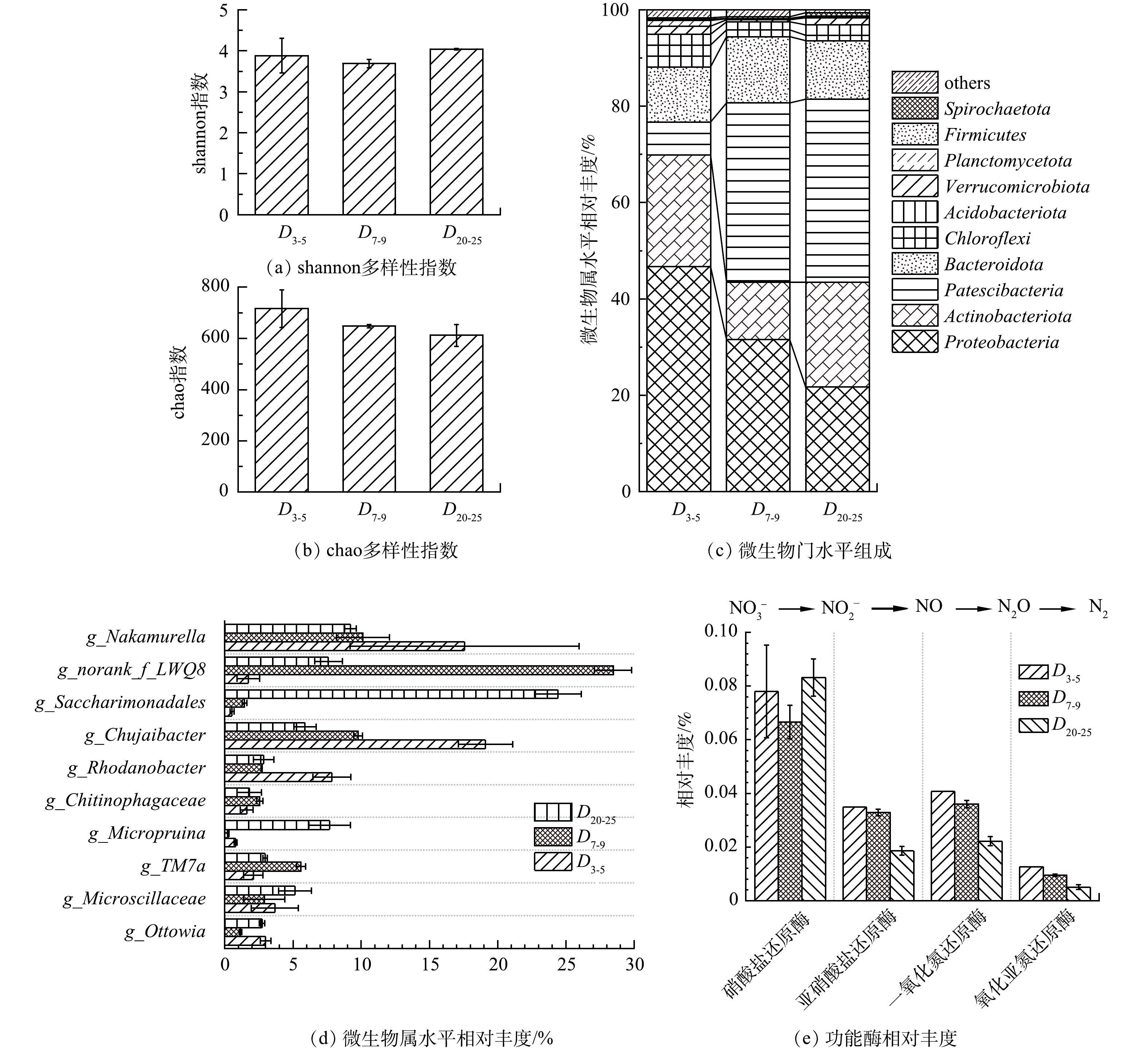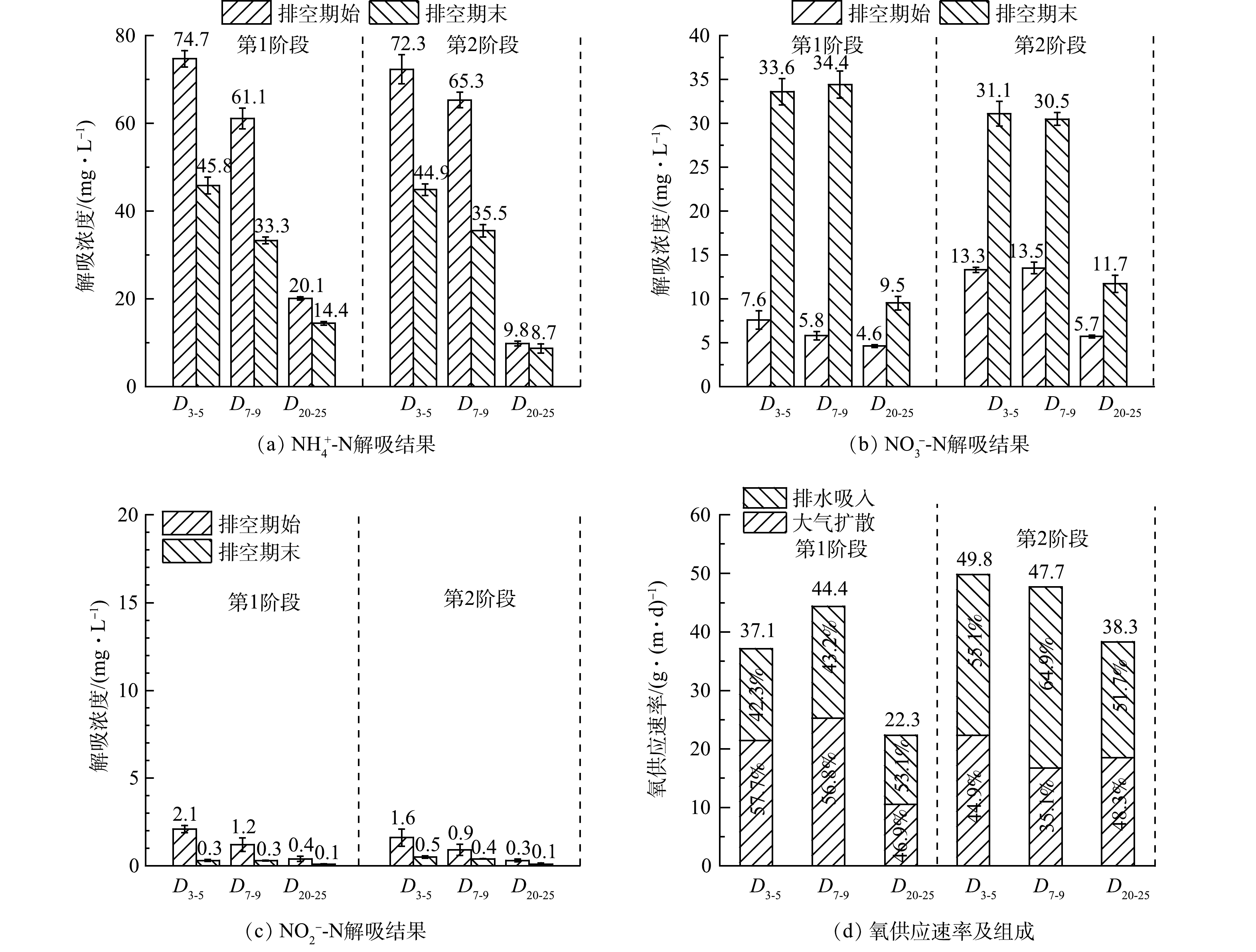-
人工湿地因其具有较低的运行成本被广泛应用于低浓度废水处理[1-2],但人工湿地进水中溶解氧浓度(dissolved oxygen, DO)仅为3~4 mg·L−1[3],氧供应问题会对污染物去除效果产生十分不利的影响[4]。潮汐流人工湿地(tidal flow constructed wetlands, TFCWs)具有良好的空气自动复氧能力,能够极大改善传统人工湿地供氧能力不足的问题,目前已有研究应用于农村污水处理[5]。
湿地潮汐运行中的排空过程是TFCWs的优势特征,排空时间的设定直接影响运行过程中的复氧和处理效果。长排空时间能够强化复氧过程,促进湿地的硝化作用和有机污染物的去除[6]。排空时间在2~36 h的研究均有所报道[7-8],排空时间差别大,处理效果也不一致,且排空时间的设定没有理论依据,建立简便实用的方法用于确定特定潮汐流人工湿地合适的排空时间十分必要。合适的排空时间与湿地微生物的耗氧过程紧密相关,但目前对TFCWs排空期氧消耗过程的研究较少,湿地氧消耗过程与污染物降解关系之间的联系没有探究。确定特定潮汐流人工湿地系统合适的排空时间有利于优化潮汐运行的策略,提高湿地处理能力。基质粒径是人工湿地系统的重要参数,粒径的选择直接影响湿地的孔隙率和比表面积[9],潮汐流人工湿地排水时,基质粒径大小影响吸入空气量和排空期氧传质过程。此前已有对湿地潮汐运行的多项研究,主要包括淹没排空时间的影响,进水水质C/N[10]等方面。但基质粒径对TFCWs处理效果的影响没有探究,不同粒径对TFCWs在排空期的氧传质过程的影响尚不明确。
基于上述原因,本研究建造了不同基质粒径的TFCWs,并以农村化粪池尾水的水质类型为处理对象,探究了基质粒径对TFCWs处理效果的影响,并从排空期氧消耗过程分析了湿地耗氧的主要时段,以期为优化TFCWs的设计运行提供参考。
-
实验系统包含3个TFCWs模拟装置(图1),基本参数如表1所示,每组人工湿地均在启动阶段种植2株美人蕉幼苗,采用合成废水模拟农村化粪池尾水,并添加微量元素满足微生物的生长需求[5]。
采用市政污水处理厂活性污泥对湿地接种挂膜。本研究在2021年8月—2022年5月持续运行10个月,分为3个阶段:启动阶段以淹没/排空=8 h:16 h(淹没/排空简称为F/D)连续运行3个月使人工湿地处理效果稳定;第1阶段以F/D=8 h:16 h运行并连续监测出水水质2个月;第2阶段以F/D=16 h:8 h稳定1个月后连续运行稳定后连续监测2个月。实验期间室内温度始终维持在20~25 ℃。
-
1)基质孔隙气体收集与氧体积占比测定。分别在第1和第2阶段的1个排空周期内连续取出湿地基质孔隙内的气体样品(湿地表面与大气正常氧交换:开放条件),每次在深度为20、40、60 cm处分别抽取20 mL气体后用便携式测氧仪(CY-12C,0.1%)测定氧体积占比,第1阶段和第2阶段的取样时间分别为排水结束后的0、0.5、1、2、4、6、8、10、12、14、16 h和0、0.5、1、2、3、4、5、6、7、8 h。此外,还测定了湿地表面封闭条件下的基质孔隙氧体积占比变化,在排水结束后使用空气阻隔膜覆盖湿地表面,使湿地内部与外部大气隔断,取样时间与开放条件一致。
2)水样采集和分析方法。单个周期排水完成后,在出水收集容器中采集出水样品,并经0.45 μm无机滤膜过滤后进行检测,采样频次为每3 d取样。NH4+-N使用纳氏试剂分光光度法测定;NO3−-N使用紫外分光光度法测定;NO2−-N使用N-(1-萘基)乙二胺分光光度法测定;COD使用快速消解分光光度法测定;DO(HQ40d, Hach, USA);pH和水温使用pH计(HACH)测定;环境温度现场测定。
3)排空期污染物的解吸。排空期开始和结束时,在D3-5深度h=20,40,60 cm处分别取相同质量的基质组成混合样,总质量m约20 g。对D7-9、D20-25以相同的方式操作。分别加入1 mol·L−1的KCl溶液100 mL[11],采用40 kHz水浴超声搅拌持续30 min,取解吸液分别测定NH4+和NO3−、NO2−质量浓度(mg·L−1),根据式(1)计算湿地吸附的污染物解吸到基质孔隙间溶液的质量浓度。
式中:Cd为吸附的污染物解吸到基质孔隙间溶液的质量浓度,mg·L−1;C为解吸液质量浓度,mg·L−1;ε为湿地孔隙率,%;m为105 ℃烘干后的基质质量,g;ρ是堆积密度,g·cm−3。
-
1)氧气扩散与环境条件。气体扩散过程使用菲克定律进行描述(式(2))。
式中:J为扩散通量,mol·(m2·s)−1;D为扩散系数,m2·s−1;C为气体浓度,mol·m−3;x为位置参数,m;负号表示传质方向与浓度差的方向相反。影响湿地氧转移过程的因素有温度、湿度、风速、光照强度、大气氧体积占比、湿地植物种类等[12-13]。在本实验条件下,湿地内外温差始终低于0.5 ℃。实验室环境处于静风状态并且湿地表层设计有15 cm超高,湿地表层风速近乎为零。实验装置所处位置海拔约为240 m,空气中氧体积分数约为20.5%。
2)排空期氧气传质过程与氧浓度变化方程。排空期某特定深度的基质孔隙氧浓度变化主要受三方面影响,来自上层的氧传递OTRin(oxygen transfer rate),向下层的氧传递OTRout(oxygen transfer rate),差值记作T=OTRin-OTRout,以及微生物的耗氧作用OUR(oxygen uptake rate)记作U。Δh高度内基质孔隙氧浓度的变化过程如式(3)所示[14]。气体中氧体积占比与气体氧浓度的换算关系如式(4)所示。
式中:C为氧气浓度,mol·L−1;P为压强,Pa;R为普适气体常量;T为温度,K;φ为氧体积占比,%。
根据亨利定律,排空时生物膜表面附着水膜的溶解氧是该处氧分压下的饱和浓度值,且氧气穿过空气-水膜界面到达生物膜的时间约为1秒[15],故排空时生物膜氧消耗被大气氧供应及时补充,实时的氧供应使基质孔隙氧体积占比的变化可以反映微生物的氧消耗状态。
3)排空期供氧量计算。排空期的供氧量的计算方法如式(5)所示。
式中:m为排空期供氧量,g;
$ \dfrac{P}{RT} $ 为标况下气体的单位体积分子量,mol·L−1;Vg为湿地孔隙气体体积,L;$\varphi(x,0)-\varphi(x,t) $ 为排空期初末态氧气浓度差值,%;x为湿地深度,cm;t为排空时间,h;A为湿地表面积,m2;ε为湿地孔隙率,%;D为氧气传质系数,m2·s−1。TFCWs的氧供应可以分为两部分,排水吸入的氧气和大气扩散进入湿地的氧气。公式的两项分别对应吸入孔隙中氧气的减少量和湿地表面向内部的扩散量。 -
在第1阶段结束时,分别从3组湿地中取出基质收集微生物样品,每组粒径均取3次平行样,样品由上海美吉生物有限公司分析,从样品中提取基因组DNA,对16S rRNA基因进行了基因组DNA提取和PCR扩增。PCR扩增使用338F(5′ACTCCTACGGGAGGCAGCA3′)和806R(5′GGACTACHVGGGTWTCTAAT3′)引物[2]。为了探索反硝化过程,通过KEGG数据库进行了相关酶的宏基因组预测和注释。
-
1)污染物整体去除效果。由表2可见,第1阶段D3-5、D7-9、D20-25的NH4+平均出水质量浓度分别为(12.36±1.47)、(9.22±1.00)、(31.59±0.87) mg·L−1;第2阶段分别为(12.97±2.80)、(8.95±1.27)、(30.32±1.00) mg·L−1,基质粒径对NH4+去除效果有显著的影响。有研究表明,石英砂(2~4 mm,F/D=16 h/8 h)、陶粒(3~4 mm,F/D=16 h/8 h)、火山岩(5~8 mm,F/D=16 h/8 h) 的NH4+去除率为15%~34%[16],本研究中砾石表现出了更好的处理效果。在2种运行方式下,D3-5、D7-9体系中均出现了明显的NO3−积累,第1阶段出水平均质量浓度分别达到(11.38±2.39) mg·L−1和(13.69±2.32) mg·L−1,第2阶段出水平均质量浓度分别达到(12.38±3.12) mg·L−1和(14.23±3.76) mg·L−1。
TFCWs的氧化还原状态由F/D持续时间控制,增加排空时间会提高硝化性能,但会抑制反硝化作用,反之亦然[17]。单级TFCWs普遍存在NO3−积累的问题,原因包括反硝化阶段C/N过低,碳源供应不足[18];或是淹没时长不足,湿地内部难以达到合适的厌氧环境。在本研究中C/N=4,相较于合适的脱氮环境[18]来说不足。NO2−积累的情况同样发生在D3-5和D7-9组中,第1阶段NO2−出水平均质量浓度分别为(8.0±1.1) mg·L−1和(10.7±1.06) mg·L−1;而第2阶段均<1 mg·L−1。NO2−的积累原因可能是反硝化进程受限[19],本研究中两阶段的NH4+去除率相差不大,意味着在排空期NH4+氧化的量相当,相比第2阶段,第1阶段的D3-5、D7-9的出水中有明显的NO2−积累,而第2阶段的淹没时间延长后,NO2−降低到<1 mg·L−1。NO2−是反硝化过程的中间产物,本实验在相同运行周期的条件下,通过延长淹没时间减少了NO2−积累,提高了TN的去除率。这说明淹没时长不足会使反硝化进程受阻,导致NO2−积累。由图2(a)可见,D20-25在2个阶段对NH4+的去除率均较低,分别为38.8%、41.0%,且出水中NO3−和NO2−质量浓度均<0.5 mg·L−1。NH4+去除率低意味着在排空期产生的NO3−少,淹没期反硝化过程可利用底物也相应减少,少量的NO3−在淹没期易于在反硝化过程被去除,故出水中NO3−和NO2−的质量浓度较低。
由图2(b)可见,D3-5、D7-9、D20-25在第1阶段的COD去除率分别为87.8%、85.6%、81.6%,第2阶段为87.8%、87.3%、85.7%。第1阶段不同基质粒径的TFCWs表现出明显的COD去除效果差异。对比不同粒径材料的TFCWs,进水COD为100~300 mg·L−1时,去除率在80%~90% [20]。
2)粒径、F/D与污染物去除之间的联系。填料和生物膜在淹没期吸附NH4+,释放NOx−,并进行反硝化过程,在排空期将吸附的NH4+氧化是TFCWs经典的污染物去除理论[15,21]。小粒径填料的人工湿地比表面积大,可供微生物附着生长的点位多,吸附能力更好;基质和生物膜的复合作用加强了基质粒径小的TFCWs的吸附力,其中生物膜对系统的NH4+吸附能力有重要贡献[22]。由第1阶段到第2阶段,D3-5、D7-9的TN去除率由45.3%和41.0%分别提升至50.5%和54.3%,D20-25的TN去除率变化不大,由39.8%增加至42.2%;D3-5的出水DO由1.30 mg·L−1降至0.99 mg·L−1,D7-9由1.47 mg·L−1降至0.83 mg·L−1,D20-25由1.48 mg·L−1降至1.02 mg·L−1。TN去除率的提升主要是出水NO2−质量浓度降低所贡献,其中D7-9出水的NO2−降低了7.46 mg·L−1,对TN去除率的增加贡献了14.5%;同周期条件下增加淹没时长能降低湿地中的DO,创造利于反硝化的环境条件,从而提高TN去除率[20]。
-
1)排空期氧传递特征。以排空时间作为横坐标,以基质孔隙氧体积占比作为纵坐标作图,如图3(a)~(b)所示。排空期某特定深度的氧体积占比变化均会经历2个过程,dC/dt表示氧浓度变化速率;C为氧浓度,%;t为排空时间,h。过程Ⅰ:dC/dt<0,即氧浓度下降阶段,在此阶段氧供应速度小于人工湿地中微生物耗氧速度,即OTR<OUR;过程Ⅱ:dC/dt>0,即氧浓度上升阶段,经历过程Ⅰ生物膜快速耗氧之后,大部分被附着有机物被降解,NH4+被氧化,随后耗氧速率逐渐下降,氧浓度梯度驱动的氧传质速率超过微生物的耗氧速度,即OTR>OUR,氧浓度逐渐上升。将湿地表层以上氧体积占比视作常量20.5%,对排空期基质孔隙氧体积占比数据使用指数和多项式复合函数进行拟合,则可以得拟合方程如式(6)所示。
式中:φ为基质孔隙氧体积占比,%;t为排空时间,h;x为湿地深度,cm。
2)粒径、F/D对排空期氧传输过程的影响。从图3(a)分析可知,相同深度下D3-5、D7-9、D20-25的基质孔隙氧体积占比分别在排空7、8、9 h左右达到最低氧体积占比,随后逐渐上升。从氧体积占比下降绝对值分析,D7-9>D3-5>D20-25。湿地氧体积占比到达最低值过后,氧体积占比上升速度不仅与微生物耗氧速度相关,还有湿地内部氧浓度梯度相关,D3-5、D7-9湿地内部氧浓度低,与外界形成的分压差大,氧体积占比上升速度比D20-25快。第2阶段如图3(b),D3-5、D7-9、D20-25排空期氧体积占比最低值分别出现在5、6、5 h,D7-9氧体积占比下降速度更快,并且能够达到的最低氧体积占比值小于其他两组。
淹没条件产生厌氧环境,控制污染物吸附和反硝化过程;而排空过程有利于有机污染物的降解和NH4+氧化[7]。对比第1、2阶段,长淹没时间的人工湿地排空期氧体积占比下降速度更快,能到达的氧体积占比值更低,且达到最低氧体积占比值的时间更短。原因在于长淹没时间导致湿地DO持续下降,以D7-9为例,从第1到第2阶段出水DO从1.47降至0.83 mg·L−1,DO降低导致排空期湿地内部的氧需求上升。
根据Fick定律,氧气扩散的传质推动力为-D·dC/dx,对氧体积占比分布方程中x求偏导可得传质推动力函数表达式,-dC/dx正比于-dφ/dt。以时间t为横坐标,-dφ/dt为纵坐标,对D3-5、D7-9、D20-25的传质推动力作图,如图3(c)~(d)所示。
从图3(c)可得,t=0 h时,氧传质速率D3-5>D7-9>D20-25,由于基质粒径差异,D3-5、D7-9初始氧传质速率相差不大,但明显大于D20-25,D7-9的氧传质速率随后迅速超过D3-5。湿地内部微生物耗氧速率越大,所造成的氧浓度梯度越大,氧传质速率也就越大。这说明D7-9在3组粒径的中产生的耗氧量最大,这与其良好的NH4+和COD去除效果密切相关。第2阶段,粒径越小则在排空期的氧传质速率越高,且短排空时间会使氧传质速率变大,3组粒径的传质速率均明显大于第1阶段。
3)湿地表面封闭条件下的基质孔隙氧体积占比变化。将D3-5、D7-9、D20-25在排空期湿地表面封闭条件下的基质孔隙氧体积占比与开放条件下氧体积占比(h=40 cm)的连续监测作图对比得图4。第1阶段封闭条件下D3-5、D7-9、D20-25基质孔隙氧体积占比均在前8 h内快速下降,随后变化趋于平缓。在湿地表面封闭的条件下,氧体积占比的下降速度约等于微生物的耗氧速度,从图4可得,排空期湿地微生物耗氧速度逐渐变小,最终平缓接近于零。排空期微生物的耗氧活动主要包括NH4+和有机污染物的氧化分解过程[21],长排空时间下可能还包括老化生物膜的氧化分解过程等。排空8 h后氧体积占比不再出现明显的下降,说明可氧化降解的NH4+和有机污染物已经在前8 h内被降解完成,更长的排空时间对提升污染物氧化效果没有明显的作用,从水质数据结果可以得到相同的结论。通过对比开放和封闭条件下的氧体积占比变化曲线可得出排空期大气扩散复氧效果,实验证明大气扩散对TFCWs湿地基质孔隙氧体积占比有显著的提升作用,在第1阶段排空期结束时,D3-5、D7-9中均提升超过了3%的氧体积占比,在第2阶段D3-5、D7-9组中提升了超过1.5%。
-
由图5(a)和图5(b)可见,3组粒径湿地的shannon指数和chao指数没有显著性差异,说明粒径对湿地内的物种多样性没有影响。如图5(c)所示,3组湿地中门水平的微生物主要包括Proteobacteria、Actinobacteriota、Patescibacteria、Bacteroidota、Chloroflexi,总占比超过90%。Proteobacteria和Patescibacteria参与反硝化过程,Actinobacteriota参与污水中有机污染物的去除,并且在D3-5中的相对丰度高于其余2组,因为氧体积占比的降低会增加Actinobacteriota的相对丰度[23],说明粒基质径小的TFCWs不利于氧供应。
在属水平上相对丰度排名前十的物种中,g__Nakamurella是异养型反硝化细菌[24],在D3-5中的相对丰度显著高于其余两组,说明其在小粒径湿地中占比更高;具有反硝化功能的菌属还包括g__Rhodanobacter、g__Micropruina、g__Ottowia,其中g__Micropruina在D20-25中相对丰度最高;此外,g__Rhodanobacter也是硝化细菌[25],在D3-5中相对丰度最高,与其较高的NO3−和NO2−的产量相匹配;g__Chujaibacter是氨氧化菌属[26],其相对丰度与粒径成反比,应该是小粒径湿地吸附了更多的NH4+,使得氨氧化菌属相对丰度上升。根据Midas数据库,g__TM7a菌属可以降解碳水化合物及参与发酵过程。根据KEGG数据库中的反硝化路径,相关的功能酶包含硝酸盐还原酶(酶编号EC为 1.7.5.1)、亚硝酸盐还原酶(EC 1.7.2.1)、一氧化氮还原酶(EC 1.7.2.5)和氧化亚氮还原酶(EC 1.7.2.4)。由图5(d)可见,反硝化功能酶在基质粒径小的湿地中相对丰度更高,D3-5出水中的NO3−和NO2−含量低于D7-9,而D20-25几乎不存在,说明小基质粒径的湿地更有利于脱氮过程。
-
解吸实验结果验证了TFCWs污染物去除的经典理论。由图6可见,排空期基质和生物膜吸附的NH4+被氧化,NO3−的量明显增加。NO2−在排空开始和结束时的解吸浓度均较低(<2 mg·L−1)。由图6(a)可见,3组基质粒径的TFCWs在稳定运行时对NH4+的吸附存在显著差异,其中D3-5、D7-9对NH4+的吸附能力更强。2个阶段中基质和生物膜对NH4+的吸附没有体现出明显的差异性,说明8 h淹没时间足以让湿地吸附进水中的NH4+和有机污染物,但排空期的产生的NO3−随时间减少而下降,说明较长的排空时间有助于NH4+的氧化过程。由图6(c)可见,3组湿地在排空期几乎不产生NO2−,这说明第1阶段D3-5和D7-9出水中NO2−是在淹没期的反硝化过程中产生的。D20-25在排空期产生了部分NO3−,但出水中几乎不含有NO3−,说明产生的NO3−在淹没期几乎全部被反硝化。本研究中,较小粒径的D3-5、D7-9体现出较好的吸附性能,可以更好地氧化NH4+,因而在排空期的基质孔隙氧体积占比显著低于D20-25。从出水水质结果分析,尽管长排空时间促进了NH4+的氧化,但并不利于在淹没期的反硝化脱氮过程,反而是第2阶段8 h排空和16 h淹没的条件下取得了更好的脱氮效果,从排空期基质孔隙氧体积占比变化分析和解吸实验均可得出此结论。
由图6(d)可见,从第1到第2阶段,排空期氧供应速率显著增大,且D3-5、D7-9的供氧速率明显高于D20-25。第1阶段D3-5、D7-9通过排水吸入空气提供给湿地的氧气量分别占42.3%、43.2%,到第2阶段提升到55.1%、64.9%。可见在TFCWs的氧供应中,随着排空时间缩短淹没时间延长,通过排水吸入的氧气在氧供应中更加重要。排空期基质孔隙留存的空气加上大气扩散作用,能够完全满足NH4+和有机污染物的耗氧量。限制排空期NH4+氧化过程的主要是淹没期结束时湿地的NH4+吸附量以及排空期基质和生物膜的解吸过程[16, 27]。基质粒径越小的湿地氧供应越依赖于大气的扩散作用,这一结果将SUN[28]对TFCWs氧供应的描述定量化,完善了氧供应的描述。
-
1)粒径对TFCWs的处理效果存在显著的影响,D3-5和D7-9可实现良好的污染物去除效果,NH4+去除率达到74.8%~82.6%,COD去除率达到85.6%~87.8%。
2)进水中约25.9%~64.8%的NH4+在排空期被氧化为NO3−,且供氧速率达到37.1~49.8 g·(m2·d)−1。运行时间从F/D=8 h:16 h到F/D=16 h:8 h证明了8 h的排空时间即可达到16 h时的NH4+去除效果,且同周期条件下延长淹没时间可提高TN去除率。
3) TFCWs排空期基质孔隙氧体积占比变化存在快速下降和缓慢上升2个过程,湿地微生物的耗氧活动主要发生在氧体积占比快速下降的过程中。通过监测排空期基质孔隙氧体积占比变化,能够优化潮汐流湿地系统的排空时间,更长的排空时间对复氧效果没有明显提升。
4)排水吸入基质孔隙的氧气和大气扩散在氧供应中均起重要作用,基质粒径越小的湿地在排空期的氧供应越依赖于大气的扩散作用。
5)在小粒径基质的湿地中氨氧化菌和反硝化菌相对丰度较高,能够增强脱氮作用。
基质粒径与排空时间对潮汐流人工湿地运行效能的影响
Effect of substrate size and drained time on the treatment performance of tidal flow constructed wetlands
-
摘要: 潮汐运行是强化人工湿地供氧的一种有效途径。为了解基质粒径对潮汐流人工湿地(TFCWs)处理效果及复氧过程的影响,研究了不同基质粒径TFCWs的处理性能,建立了TFCWs排空期氧转移过程的研究方法。结果表明基质粒径影响湿地对NH4+的吸附性及排空期基质孔隙氧体积占比进而影响处理效果,7~9 mm基质粒径的湿地达到最佳的氨氮去除率82.6%,3~5 mm基质粒径的湿地达到最佳的COD去除率88.2%,粒径基质小的湿地中氨氧化菌属和反硝化菌属的相对丰度更高,脱氮能力强;分析排空期基质孔隙氧体积占比变化与湿地微生物耗氧过程的联系,能够优化潮汐流湿地系统的排空时间,湿地微生物的耗氧活动主要集中在氧体积占比快速下降阶段,更长的排空时间对复氧能力没有明显提升,本研究中8 h的排空时间即可满足湿地系统的氧需求。Abstract: Tidal operation is an effective technique to enhance the oxygen supply of constructed wetlands. In order to explore the effect of substrate particle size on the treatment performance and reoxygenation process of tidal flow constructed wetlands (TFCWs), the treatment performance of TFCWs with different substrate particle sizes was studied, and the studying method of oxygen transfer process in TFCWs during drained period was established. The results showed that particle size of the substrate affected the adsorption of NH4+ and oxygen concentration during the drained period, which in turn affected the treatment performance. The wetland with 7~9 mm substrate achieved the best ammonia removal rate of 82.6%, and wetland with 3~5 mm substrate achieved the best COD removal rate of 88.2%. The wetland with small substrate particle size had higher relative abundance of ammonia oxidizing bacteria and denitrifying bacteria, which had advantages in denitrification. Analyzing the relationship between the change in oxygen concentration and the oxygen consumption process during the drained period can optimize the drained time of TFCWs. The oxygen consumption activity of microorganisms was mainly concentrated at the rapid decline stage of oxygen concentration. The longer drained time did not significantly improve the reoxygenation ability. In this study, the drained time of 8 hours can meet the oxygen demand.
-

-
表 1 实验组设置及基本参数
Table 1. Experimental group setting and basic parameters
实验组 基质粒径/mm 孔隙率/% 有效工作容积/L D3-5 3~5 43.5 10.9 D7-9 7~9 41.5 10.4 D20-25 20~25 40.7 10.2 表 2 潮汐流人工湿地污染物去除效果
Table 2. Treatment performance of TFCWs
mg·L−1 组别 第1阶段 第2阶段 NH4+-N NO3−-N NO2−-N COD NH4+-N NO3−-N NO2−-N COD 系统进水 51.66±2.21 1.44±0.80 0.00±0.01 209.0±20.5 51.43±2.33 1.44±0.80 0.00±0.01 206.3±18.2 D3-5出水 12.36±1.47 11.38±2.39 5.27±1.14 25.1±4.1 12.97±2.80 12.38±3.12 0.73±0.87 24.3±7.9 D7-9出水 9.22±1.00 13.69±2.32 8.37±1.06 29.5±5.4 8.95±1.27 14.23±3.76 0.91±1.06 25.6±9.6 D20-25出水 31.59±0.87 0.23±0.18 0.09±0.10 38.2±6.4 30.32±1.00 0.15±0.11 0.03±0.06 28.6±9.9 -
[1] GAO F, LIU G C, SHE Z L, et al. Effects of salinity on pollutant removal and bacterial community in a partially saturated vertical flow constructed wetland[J]. Bioresource Technology, 2021, 329: 124890. doi: 10.1016/j.biortech.2021.124890 [2] FANG D X, ZHAO G, XU X Y, et al. Microbial community structures and functions of wastewater treatment systems in plateau and cold regions[J]. Bioresource Technology, 2018, 249: 684-693. doi: 10.1016/j.biortech.2017.10.063 [3] WANG Z, HUANG M L, QI R, et al. Enhanced nitrogen removal and associated microbial characteristics in a modified single-stage tidal flow constructed wetland with step-feeding[J]. Chemical Engineering Journal, 2017, 314: 291-300. doi: 10.1016/j.cej.2016.11.060 [4] LU J X, GUO Z Z, KANG Y, et al. Recent advances in the enhanced nitrogen removal by oxygen-increasing technology in constructed wetlands[J]. Ecotoxicology and Environmental Safety, 2020, 205: 111330. doi: 10.1016/j.ecoenv.2020.111330 [5] Cao X K, JIANG L, ZHENG H, et al. Constructed wetlands for rural domestic wastewater treatment: A coupling of tidal strategy, in-situ bio-regeneration of zeolite and Fe(Ⅱ)-oxygen denitrification[J]. Bioresource Technology, 2022, 344: 126185. doi: 10.1016/j.biortech.2021.126185 [6] WU S B, ZHANG D X, AUSTIN D, et al. Evaluation of a lab-scale tidal flow constructed wetland performance: Oxygen transfer capacity, organic matter and ammonium removal[J]. Ecological Engineering, 2011, 37(11): 1789-1795. doi: 10.1016/j.ecoleng.2011.06.026 [7] XU D, LIN L L, XU P, et al. Effect of drained-flooded time ratio on ammonia nitrogen removal in a constructed wetland-microbial fuel cell system by tidal flow operation[J]. Journal of Water Process Engineering, 2021, 44: 102450. doi: 10.1016/j.jwpe.2021.102450 [8] CUI L H, FENG J K, OUYANG Y, et al. Removal of nutrients from septic effluent with re-circulated hybrid tidal flow constructed wetland[J]. Ecological Engineering, 2012, 46: 112-115. doi: 10.1016/j.ecoleng.2012.06.003 [9] 张翔, 李子富, 周晓琴, 等. 我国人工湿地标准中潜流湿地设计分析[J]. 中国给水排水, 2020, 36(18): 24-31. doi: 10.19853/j.zgjsps.1000-4602.2020.18.005 [10] TAN X, YANG Y L, LIU Y W, et al. Quantitative ecology associations between heterotrophic nitrification-aerobic denitrification, nitrogen-metabolism genes, and key bacteria in a tidal flow constructed wetland[J]. Bioresource Technology, 2021, 337: 125449. doi: 10.1016/j.biortech.2021.125449 [11] HAN Z F, DONG J, SHEN Z Q, et al. Nitrogen removal of anaerobically digested swine wastewater by pilot-scale tidal flow constructed wetland based on in-situ biological regeneration of zeolite[J]. Chemosphere, 2019, 217: 364-373. doi: 10.1016/j.chemosphere.2018.11.036 [12] REHMAN F, PERVEZ A, KHATTAK B N, et al. Constructed Wetlands: Perspectives of the oxygen released in the rhizosphere of macrophytes[J]. Clean-Soil Air Water, 2017, 45(1). [13] WANG X O, BAI J, TIAN Y M, et al. Synergistic effects of natural ventilation and animal disturbance on oxygen transfer, pollutants removal and microbial activity in constructed wetlands[J]. Chemosphere, 2021, 283: 131175. doi: 10.1016/j.chemosphere.2021.131175 [14] MOHAN. T R, KUMAR M S M, RAO L. Numerical modelling of oxygen mass transfer in diffused aeration systems: A CFD-PBM approach[J]. Journal of Water Process Engineering, 2021, 40: 101920. doi: 10.1016/j.jwpe.2021.101920 [15] AUSTIN D, NIVALA J. Energy requirements for nitrification and biological nitrogen removal in engineered wetlands[J]. Ecological Engineering, 2009, 35(2): 184-192. doi: 10.1016/j.ecoleng.2008.03.002 [16] LIU M H, WU S B, CHEN L, et al. How substrate influences nitrogen transformations in tidal flow constructed wetlands treating high ammonium wastewater?[J]. Ecological Engineering, 2014, 73: 478-486. doi: 10.1016/j.ecoleng.2014.09.111 [17] JIA W L, ZHANG J, WU J, et al. Effect of intermittent operation on contaminant removal and plant growth in vertical flow constructed wetlands: A microcosm experiment[J]. Desalination, 2010, 262(1): 202-208. [18] ZHI W, JI G D. Quantitative response relationships between nitrogen transformation rates and nitrogen functional genes in a tidal flow constructed wetland under C/N ratio constraints[J]. Water Research, 2014, 64: 32-41. doi: 10.1016/j.watres.2014.06.035 [19] LI C Y, WU S B, DONG R J. Dynamics of organic matter, nitrogen and phosphorus removal and their interactions in a tidal operated constructed wetland[J]. Journal of Environmental Management, 2015, 151(310): 310-316. [20] LI L Z, HE C G, JI G D, et al. Nitrogen removal pathways in a tidal flow constructed wetland under flooded time constraints[J]. Ecological Engineering, 2015, 81: 266-271. doi: 10.1016/j.ecoleng.2015.04.073 [21] AUSTIN D, LOHAN E, VERSON E J P W E F. Nitrification and denitrification in a tidal vertical flow wetland pilot[J]. Proceedings of the Water Environment Federation, 2003, 40(31): 333-357. [22] HU Y S, ZHAO Y Q, RYMSZEWICZ A. Robust biological nitrogen removal by creating multiple tides in a single bed tidal flow constructed wetland[J]. Science of the Total Environment, 2014, 470-471: 1197-1204. doi: 10.1016/j.scitotenv.2013.10.100 [23] ZHAO D, GAO P, XU L, et al. Disproportionate responses between free-living and particle-attached bacteria during the transition to oxygen-deficient zones in the Bohai Seawater[J]. Science of the Total Environment, 2021, 791: 148097. doi: 10.1016/j.scitotenv.2021.148097 [24] KIM K K, LEE K C, LEE J-S. Nakamurella panacisegetis sp. nov. and proposal for reclassification of Humicoccus flavidus Yoon et al., 2007 and Saxeibacter lacteus Lee et al., 2008 as Nakamurella flavida comb. nov. and Nakamurella lactea comb. nov[J]. Systematic and Applied Microbiology, 2012, 35(5): 291-296. doi: 10.1016/j.syapm.2012.05.002 [25] GONZALEZ-MARTINEZ A, RODRIGUEZ-SANCHEZ A, GARCIA-RUIZ M J, et al. Performance and bacterial community dynamics of a CANON bioreactor acclimated from high to low operational temperatures[J]. Chemical Engineering Journal, 2016, 287: 557-567. doi: 10.1016/j.cej.2015.11.081 [26] ZHENG H, JIANG L, CAO X K, et al. A combined deodorization reflux system and tidal flow constructed wetland for sewage treatment performance[J]. Journal of Environmental Chemical Engineering, 2022, 10(1): 106953. doi: 10.1016/j.jece.2021.106953 [27] AUSTIN D W L, STROUS M. Mass transport and microbiological mechanisms of nitrification and denitrification in tidal flow constructed wetland systems[J]. 10th International Conference on Wetland Systems for Water Pollution Control, 2006, 209-216. [28] SUN G Z, ZHAO Y Q, ALLEN S. Enhanced removal of organic matter and ammoniacal-nitrogen in a column experiment of tidal flow constructed wetland system[J]. Journal of Biotechnology, 2005, 115(2): 189-197. doi: 10.1016/j.jbiotec.2004.08.009 -




 下载:
下载:








